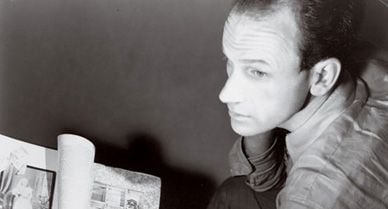Pas de Deux
Joseph Cornell turned his obsession with a prima ballerina into art
/https://tf-cmsv2-smithsonianmag-media.s3.amazonaws.com/filer/object_swan.jpg)
Picture a man living in a small house on Utopia Parkway in Flushing, Queens, just across the East River (and worlds away) from Manhattan. He is in his late 30s and lives with his mother and an invalid brother. On a given evening in the winter of 1941, he climbs the stairs to the elevated train that will take him into what people in Queens still call "the city," where he will attend the ballet, as is his habit.
Perhaps he has chosen to attend Tchaikovsky's romantic Swan Lake, a favorite of balletomanes. And perhaps, on this particular evening, he will watch a dazzling young ballerina dance the demanding Black Swan pas de deux and, seeing her spin dizzyingly on pointe, will feel his heart beat faster.
But the admirer watching the graceful swan was not just anyone. He was the unique and eccentric artist Joseph Cornell, and if not exactly a man about town, neither was he, as some biographers have suggested, painfully shy. "The picture of a person withdrawn from the world," says art historian Lynda Hartigan, of the Peabody Essex Museum in Salem, Massachusetts, "is not a characterization of Cornell that I find accurate or useful." Hartigan, along with curators at the Smithsonian American Art Museum (SAAM), organized the current traveling exhibition of Cornell's works.
While other men may have daydreamed about ballerinas, Cornell transformed his appreciation into art; in 1946 he produced a box construction that he called A Swan Lake for Tamara Toumanova: Homage to the Romantic Ballet. (Today, it constitutes one of 177 works included in the show, installed at SAAM through February 19.)
Toumanova was a superstar, back when the word was still reserved for the extraordinary. Born in Russia (in a boxcar, she claimed), the daughter of a czarist military officer and his wife who were fleeing the Bolsheviks, she grew up in Paris and danced at the Paris Opera at the age of 9. According to the dancer's 1996 obituary in the New York Times, a prominent Parisian critic described her dancing as "astonishing" and "frightening." She was famous at 13, a protégée of legendary choreographer George Balanchine, performing in London and New York. By the time Cornell constructed his homage to Toumanova, she was 27 years old and an international celebrity.
Hartigan says that Cornell was introduced to Toumanova in 1940 by the Russian émigré painter and theatrical designer Pavel Tchelitchev and likely saw her dance often in the early '40s. In the 1970s, Toumanova told Hartigan that she considered Cornell a friend; the pair, says Hartigan, "corresponded on and off for at least two decades."
The box dedicated to her measures 9 1/2 inches by 13 inches by 4 inches and contains another, smaller box with a window of blue glass, behind which a cutout of a swan from the photostat of an old lithograph drifts past a castle (thus echoing the ballet). The intricate box, lined with blue velvet, contains pieces of mirror mounted on the rear surface. The larger box features several white feathers, which Hartigan notes were taken from one of Toumanova's costumes. The dancer told the art historian that in those simpler days, Cornell would occasionally wait in the wings, scissors in hand, to snip bits from her ensembles.

By the time they met, Cornell, whose first one-man exhibition opened at the Julien Levy Gallery in New York in 1932, was a well-respected artist, admired by prominent Surrealists. He was as well known in his world as Toumanova was in hers, though he chose to work in almost cloistered privacy, on his kitchen table and in a basement space. His boxes are introspective miniatures, not muscular showpieces. Whatever the nature of their friendship, the stylistic distance between the genius and the goddess—one living quietly in a working-class borough, the other receiving "bravas" and bouquets night after night from frenzied fans—was in some sense unbridgeable.
But Cornell must have imagined that there might be something between them, or so it would seem. The letters he wrote to her often bore red heart decals. When the dancer married screenwriter Casey Robinson in 1944, the letters continued but the hearts disappeared—only to return when Toumanova's marriage ended in divorce ten years later.
Cornell died in 1972, at age 69 at home in Flushing, 24 years before Toumanova, who spent her last days in Beverly Hills, living out a genteel retirement. He had never married.
Owen Edwards is a freelance writer and author of the book Elegant Solutions.
/https://tf-cmsv2-smithsonianmag-media.s3.amazonaws.com/accounts/headshot/Owen-Edwards-240.jpg)
/https://tf-cmsv2-smithsonianmag-media.s3.amazonaws.com/accounts/headshot/Owen-Edwards-240.jpg)